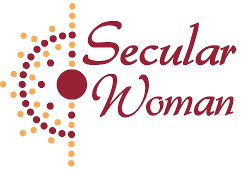If you are neutral in situations of injustice, you have chosen the side of the oppressor. If an elephant has its foot on the tail of a mouse, and you say that you are neutral, the mouse will not appreciate your neutrality.
Desmond Tutu
At its most repugnant, the belief that women must be subjugated to the wishes of men excuses slavery, violence, forced prostitution, genital mutilation and national laws that omit rape as a crime. But it also costs many millions of girls and women control over their own bodies and lives, and continues to deny them fair access to education, health, employment and influence within their own communities.
Jimmy Carter
Finally, it’s time for women’s rights to be seen not as a “special” issue but as something integral to our [secular movement] larger mission of freeing society from anti-rational, supernaturally based restrictions.
Susan Jacoby
The following is an overview of treatment of women in the secular community by some, the results of this treatment, examples of fallicies used to argue against feminist principles, and suggestions for a way forward.
Definitions and Concepts
Sexism
From Wikipedia: sexism is prejudice or discrimination based on sex; especially discrimination against women and, or behavior, conditions, or attitudes that foster stereotypes of social roles based on sex. It may include the belief that a human of one sex is intrinsically superior to the other. Sexist claims are usually based on real or alleged differences between men and women. More specifically, common sexist claims stem from traditional stereotypes of patriarchal gender roles. According to dictionaries, the term sexism commonly refers to discrimination against women; however, sexism can also apply to men.
Sexism may include: having male and male activities be the default, having a disproportionate number of any one gender in an organization or at a particular level of an organization, refusing to allow women a clear and distinct voice. Sexism may be conscious or unconscious, intentional or unintentional.
If secular organizations feel comfortable talking and advocating for science education, which is not directly related to religion . . . why not vigorously advocate for issues typically labeled “women’s issues.”
Fairness
This picture illustrates the difference between treating everyone the same and treating everyone with fairness with respect to their differing needs.

Reality Women Face in the Secular Movement
Now lets look at some of the things frequently confronting women in the secular movement, especially outspoken women who are visible (i.e. bloggers, public figures, etc).
1.1 Quotes, Memes, Sentiments
The following examples are pulled form many places all over the internet and offline and represent some of the vitriol directed at women in the secular movement and well as some of the seemingly innocuous behaviors that have a negative cummulative effect.
a) Some memes created to antagonize women



b) “Strong women don’t need people promoting them” – advisory board chair in response to suggestion of identifying/adding more women
c) Groups of men in private discussions referring to a woman on a secular board as “The Cunt.”
d) Less diversity is OK if it is the result of a more exclusionary group. – sentiment expressed in mulitiple venues
e) Personal example: I have felt awkward and uncomfortable many times in the Atheist community because I am not a geek and I like many feminine things.
f) Get your feminism out of my humanist organization – sentiment expressed on various online communities
g) “I wish people representing atheists would be mature, engage in a dialogue, act like other community leaders. “
h) In a personal example, when my partner and I began attending critical thinking groups we were shocked by the sexism present and ended up opting out of the group
1.2 The results of this behavior:
a) Misogyny, intimidation, silencing – the realities of online bullying
b) The aggregated effect of floods of negative comments online can be enough to put opinionated women off appearing in public.
It’s about bias. It’s about sexism It’s about intimidation. It’s about silencing.
c) Women bloggers are driven from the community due to harassment.
d) Women are more reluctant to join movement when they perceive a culture that endorses sexism, unconcious bias, etc through inaction and silence.
These types of behaviors are clearly a problem, but when women (and male allies) attempt to address them they are often met with resistance and the conversation drifts toward common fallacies regarding feminism.
An Examination of Fallacies Directed at Feminists in Secularism
Below is an examination of some of the fallacies used in arguments against feminism and a feminist perspective.
1.1 Fallacy of division
a) What is it? Occurs when one reasons that something true of a thing must also be true of all or some of its parts.
b) Link: http://en.wikipedia.org/wiki/Fallacy_of_division
c) An example:
Feminists say that white males are privileged.
I am a white male.
In my estimation, I did/do not have an easy life.
Therefore the feminist idea that white males are privileged is false.
1.2 Strawman Arguments
a) Radical feminists that represent all feminism and who hate men. Man hating feminists are a rare occurence and are regarded as fringe by the feminist movement. Claiming that the actions of a few represent all is a strawman.
b) Comment From Ron Lindsay’s Thread Re: HEADS. I wish you would stop with the propaganda that women are not accepted at atheist and skeptic conventions and conferences. Because you happen to feel personally that you do not belong does not mean that others do and if you could abstain from thinking you represent and speak for women in the community and elsewhere, I would appreciate it. Thanks. [–Ophelia did not claim to speak for all women (Strawman)]
c) Comment From Ron Lindsay’s Thread Re: HEADS. Regarding feminism influencing missions, I think you’re being biased. The religious may wish to pass legislation on what women should or shouldn’t do with their own bodies, but rather than say it’s a feminist issue (or a feminist issue outright), it’s a human rights issue and should be treated more as such. Humanism and secularism go well together because of their lack of dogma, but feminism is an ideology (arguably the main tenet is humanist, but the rest is unequivocally dogmatic) and therefore should not be conflated with secular and humanist concerns. [–Strawmanning (Feminism=dogma)]
1.3 Non-Sequitor
a) Claiming bias is a non sequitur as it does not address the argument and having a viewpoint does not make you wrong.
Even if not confronted by these fallacies many people argue about the validity of including anthing beyond a narrow scope into the secular/atheist movement because of their definition of what atheism really is about.
The Argument About What Atheism Really is or “The Purity Test”
1.1 The argument:
Atheism is ONLY about a lack of belief in god.
1.2 The rebutall:
The atheism and secularism we are discussing is, in fact, a social movement; not simply a dictionary definition.
Secular organizations do advocate for social (and other) issues that are broader than a lack of belief in any god, including: health and safety, education, tax policy, discrimination, government actions, military, international, complete and total separation of church and state, scientific integrity, human rights for all, promoting peace, reproductive freedom, women’s rights, LGBT rights, civil rights in America, etc.
So, the idea of this purity test fails before it begins.
***UPDATE ****
The American Humanist Association response:
We’re quite regularly vocal on women’s issues. In fact, we have an action alert on the ERA action right now and our annual lobbying on the Violence Against Women Act is about to move into high gear. Our Humanist of the Year last year was Gloria Steinem and we regularly recognize other leading feminists as well as give the Feminist Heroine award every year. We are active members of the International Family Planning coalition in Washington as well as other women’s rights focused efforts. And we have a Feminist Caucus in it’s third decade of operation that helps add focus to our feminist outreach on both the local and the national level.
See full response here.
The Results of These Obstacles
These type of obstacles to participation wear on women and have a deliterious effect on their desire to join and participate. Some women are, and may, choose to withdraw alltogether and spend their time on other causes. The below comment is from a member of Secular Woman on our member’s only Facebook page.
I’ll be honest and say my interest in the atheist/humanist/secular community is fading pretty fast and I’ve not been here that long. It’s like, as a woman, you have to walk around on eggshells because one “wrong” word and you have a group of people completely trying to ruin your career and slandering you all over the internet through videos, blog posts, social media, and even calling your place of employment. The worst thing about that is it’s the people that are supposed to be your allies; it’s not the fundamentalist Christians, it’s fellow atheists.
If Ron Lindsey cannot see how feminism and secularism intersect, well I just cannot get that worked up about it. Let the white males keep the movement and they can all just sit around patting themselves on the back while it dies a slow death. Women are quickly becoming the primary breadwinners in their families, they are still the primary child caregivers, are more involved in their child’s schools, and because of all of the anti-woman legislation this would be the prime time to get them involved in making sure our government remains secular.
The women in this movement have to spend all of their time trying to convince men in the movement that we matter and fighting off attacks instead of being able to focus on making change in legislation. It takes very little time to realize this and women will simply go elsewhere.
The primary reason I rejected religion was because of the way women were treated and talked about. I was drawn to this movement because of religious influence in our government and how that was impacting my rights as a woman. I can fight that type of legislation in the feminist movement, though, and not have to deal with harassment from other feminists.
If CFI or anyone else thinks they are going to be able to keep women in the movement by ignoring how religion is impacting our rights, then they are going to alienate even more people. Less people = less influence.
I’m not even been much of a participant, but just an observer and I’m already starting to disengage. I’m a feminist first and somewhere down the line an atheist.
Information That Can Give Insight Into Retaining Women
Data from the secular census is instructive in helping to understand what women want out of the movement, what draws them in, and what pushed them out. Below is a brief examination of some of that data.
Secular Census
1.1 Overview: Women want groups that do more than criticize religion. They want to focus on positive messages and education. They’d like their groups to share their values and take positions that reflect those values. They’d like their interactions to be positive; they don’t see the point of supporting groups where they will have to deal with assholes on a regular basis. They want to feel safe from unwanted advances. They could use some help with childcare. And while they are atheists (the most common identifier among both men and women), they are more likely than men to attend church or use a religious identifier — so groups where there is hostility or ridicule about religious participation are probably not going to feel welcoming to them.
1.2 Regardless of gender, all respondents who are or have been involved in the secular movement are asked: Have you ever felt unwelcome, discriminated against, or harmed in the secular movement? Women outnumber men 62%/34% in responding “Yes.” It is worth noting that women do not outnumber men when asked the same question about religious organizations with which they’ve been associated. It appears they are less comfortable in secular groups than in the churches they left.
1.3 Details on women’s responses re: benefits/disadvantages to participating in secular identity organizations:
a) These questions were answered only by those who’ve been involved, or are currently involved. This analysis simply gives women’s responses, by percentage of all women responding.
b) What benefits have you personally experienced from your involvement in the secular movement? Check as many as apply.
84.2% Friendships and community
56.8% Social or cultural acceptance
50.0% Personal development (confidence, leadership, etc.)
35.6% Educational resources
32.9% Service opportunities
18.5% Support with family issues
10.9% Something not listed here
13.0% Political influence
11.6% Moral guidance
10.9% Support with other problems
05.5% Career opportunities
03.4% Youth programs
02.7% No benefits at all
00.7% Support with substance abuse
c) What disadvantages have you personally experienced from your involvement in the secular movement? Check as many as apply.
52.7% No disadvantages at all
24.7% Problems with family members
13.7% Problems with friends
12.3% Problems in the workplace
11.6% Problems within the organization itself
08.9% Conflict with mission or values
08.2% Problems in my community
06.8% Something not listed here
This information can be helpful to organizations seeking to engage women more fully. Addtionally it is helpful to consider other barriers to women’s full participate; one such barrier is the threshhold of gender balance before women feel comfortable (in general) speaking up with frequency. Below is an examination of a study into this:
Gender Inequality in Deliberative Participation Study
Study was authored by:
CHRISTOPHER F. KARPOWITZ Brigham Young University
TALI MENDELBERG Princeton University
LEE SHAKER Portland State University
1.1 Selected Introduction
Can men and women have equal levels of voice and authority in deliberation or does deliberation exacerbate gender inequality? Does increasing women’s descriptive representation in deliberation increase their voice and authority? We answer these questions and move beyond the debate by hypothesizing that the group’s gender composition interacts with its decision rule to exacerbate or erase the inequalities. We test this hypothesis and various alternatives, using experimental data with many groups and links between individuals’ attitudes and speech. We find substantial gender gaps in voice and authority, but, as hypothesized, it disappears under unanimous rule and few women, or under majority rule and many women. Deliberative design can avoid inequality by fitting institutional procedure to the social context of the situation.
For example, Johnson and Schulman (1989) found that women’s influence is rated lower when they are in a numerical minority and that the effect of numerical minority status is greater on women than on men. This effect comes from status, which gives people a sense of entitlement to take and keep the floor; talking more leads, in turn, to more perceived influence (Fiske 2010). The fewer women in the group, the lower their status, the less they may speak, and the lower their influence. A variety of studies thus lead us to expect that, when women discuss political issues with men, they will defer to the assumed expertise and displayed confidence of men (Aries 1998; Bowers, Steiner, and Sandys 2001; Croson and Gneezy 2009; Eagly 1987; Giles et al. 1987; Hastie, Penrod, and Pennington 1983; Huckfeldt and Sprague 1995; Ridgeway 1982; Strodtbeck, James, and Hawkins 1957).
In settings with many men, the interaction tends to take on more stereotypically masculine characteristics of individual assertion, agency, competition, and dominance; in contrast, in settings with many women, people tend to interact in a more stereotypically feminine style that emphasizes cooperation, intimacy, and the inclusion of all participants (Aries 1976; Dindia and Allen 1992; Ellis 1982; McCarrick, Manderscheid, and Silbergeld 1981; Miller 1985; Smith-Lovin and Brody 1989; see Mendelberg and Karpowitz 2007).
1.2 Selected Conclusions
a) Mixed-gender combinations: “Even if men and women enter deliberation with the same preferences and equal formal rights, the disproportionate exercise of these rights by men erodes the political and civic standing of women, a group not yet equal in society.”
b) When women outnumber men, use unanimous rule; when women are a large majority, decide by majority.
c) To maximize women’s individual participation, gender-homogenous groups are best.
d) “Even if men and women enter deliberation with the same preferences and equal formal rights, the disproportionate exercise of these rights by men erodes the political and civic standing of women, a group not yet equal in society.”
Additionally, Secular Woman reviewed the gender compostion of several major Secular Organizations and wrote up our findings:
Gender Statistics in Secular Movement
See Implications of Gender Disparities in Secular Leaderships
Understanding the Obstacles and Applying Fairness
To help understand the obstacles that disadvantaged groups faced it is beneficial to have a working understanding of some social justice concepts. One of the main underpinnings of social justice is the concept of privilege. Here are a few different ways to think about this principle.
A way to conceptualize privilege
1.1 Imagine life here in the US — or indeed, pretty much anywhere in the Western world — is a massive role playing game, like World of Warcraft except appallingly mundane, where most quests involve the acquisition of money, cell phones and donuts, although not always at the same time. Let’s call it The Real World. You have installed The Real World on your computer and are about to start playing, but first you go to the settings tab to bind your keys, fiddle with your defaults, and choose the difficulty setting for the game. Got it?
Okay: In the role playing game known as The Real World, “Straight White Male” is the lowest difficulty setting there is.
So, after examining how women are deincentivised and some of the research into how they can be included, lets take a look at some concrete steps that can be taken by the secular community to fully include women and remove barriers to their participation.
Specific Action Items for Inclusion of Women in the Secular Movement
1.1 Immediate and public consequences for harassment, bullying, and the like.
1.2 More national leaders consistently speaking out about inclusion, diversity, and women.
1.3 Increase the number of women to 60% in leadership positions at all levels of national, regional, and local organizations. See study on gender deliberation (available via the Secular Woman website when this presentation is published).
1.4 Increase the number of women speakers at conferences.
1.5 Increase the number of women visible in marketing materials.
1.6 Secular activism organizations including reproductive concerns as part of their mission.
1.7 Realize there is a portion of the community that exists on the internet. Take what happens there seriously. Participate in this segment of the community.
1.8 Have minority speakers at conferences talk about their areas of expertise.
1.9 Listen to women and their experiences; use that information to make inclusive decisions regarding your organization(s).
1.10 Partner with groups focused on minority memberships.
1.11 Be clear and vocal that women and feminist thought are rational.
1.12 Do not tolerate anti-woman rhetoric in your presence; speak out against it, immediately, directly, and with no equivocation.
1.13 Review your mission and programs to ensure they are inclusive of women and ideas that women value.
1.14 Have more regular turn over at the Executive Director and Board level to ensure that the organizations are growing and evolving along with the secular community.
1.15 Do not promote people to leadership with histories of harassment and the like.
1.16 Do not shuffle people from organization to organization with a history of problematic behavior(s).
1.17 Have conversations with leaders in the minority communities. Ask them what specific concerns they face, what can be done, what others can do. And then take steps to do those things.
1.18 Show diversity via your marketing.
1.19 Control/limit speaking time so that all have the same amount.
1.20 Choose messaging that speaks to women and other minorities.
1.21 Loosen the preference for speakers that are published. Scholarly publishing has its own bias toward men.
1.22 Provide childcare.
1.23 More consideration given to providing for a range of access to events.
1.24 Host events that are not centered around lectures or workshops.
Future of Atheism/Secularism Social Movement in US
1.1 Atheism … blossoms amid affluence where most people feel economically secure. Link: http://www.psychologytoday.com/blog/the-human-beast/201107/why-atheism-will-replace-religion-new-evidence
1.2 Gender Percentages:
a) Women in US: 50.8%
b) Secular Census = 42% women respondents
c) Atheist Census = 25.5% women respondents
d) Pew Research. Nones on the rise. This group is unaffiliated religiously. This category rose 4.3% from 2007 to 2012. Also, 1/3 of adults under 30 are religiously unaffiliated.
e) Atheist Census: Atheism increases with education
f) Women Graduating College = 25% fewer men received college degrees in 2009.
g) Where is the future of the secular social movement? Women; based on overall percent of population, educational levels, and the opportunity for growth by gender.
h) The decisions you make now for yourself and your organizations are the ones that you will be looking back on in 30 years. Don’t be Strom Thurmond opposing the Civil Rights Act of 1957.

Be on the right side of history.
Hillary Clinton
